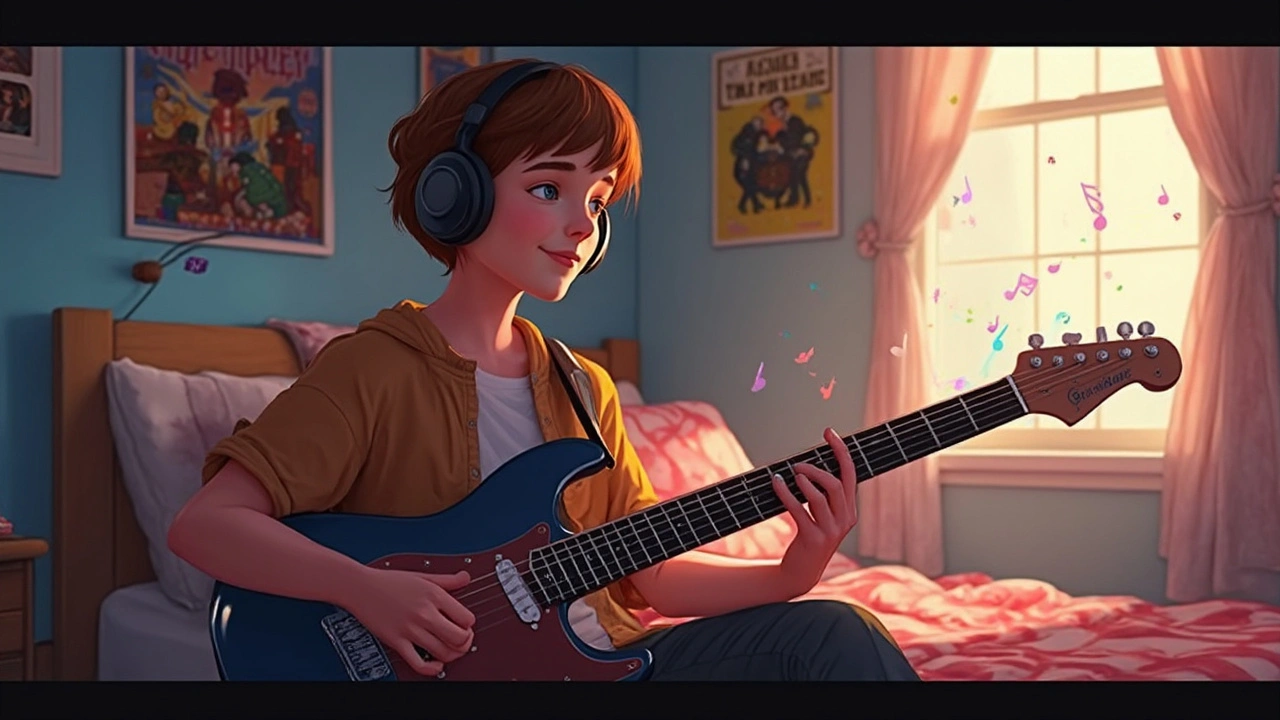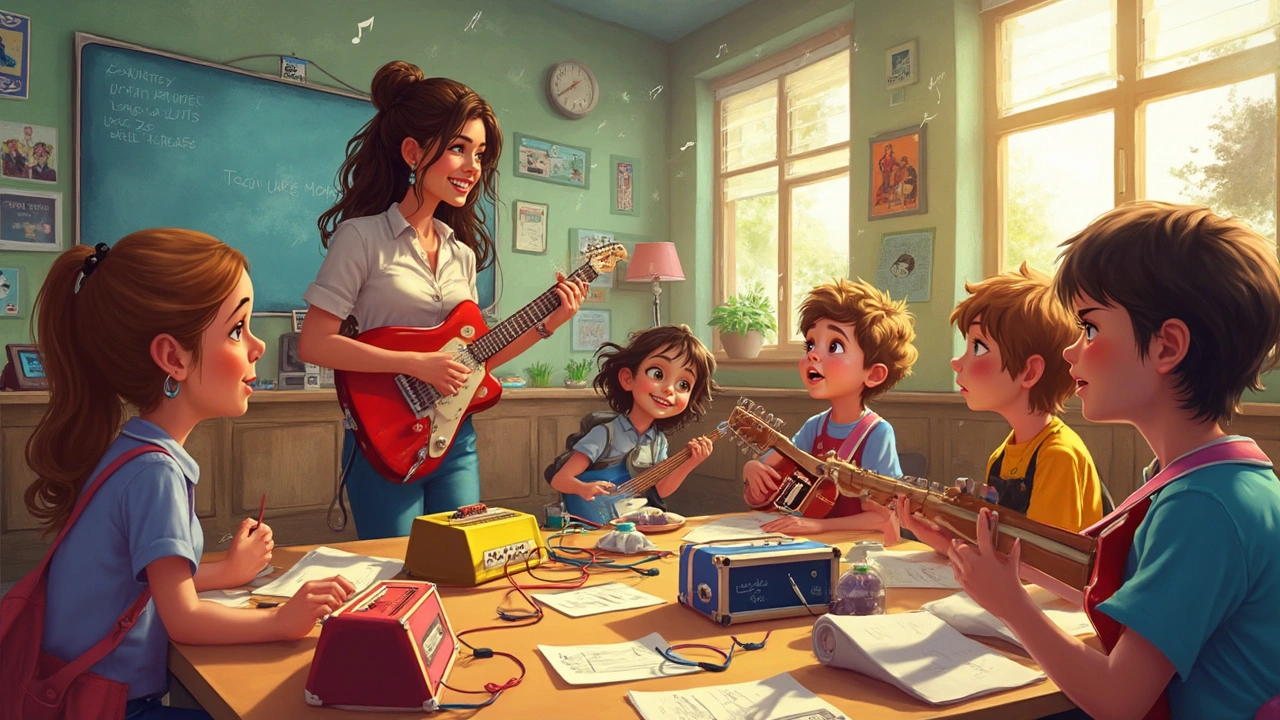Think electric guitars are just for rock bands? Classrooms and music schools today are loaded with them for a good reason—they’re fun, versatile, and way easier to handle for beginners than you might guess. Students get excited to pick up an electric, mostly because it feels more like play than work. And when students are excited, they actually stick with music longer.
The first thing to know: electric guitars don’t need a ton of finger strength compared to classical or acoustic guitars. The lighter strings and slimmer necks are perfect for smaller hands or anyone who struggles with the old-school six-string. And volume issues? Just plug in some headphones, and nobody else has to hear your practice runs. That’s a game changer for households or classrooms where peace and quiet matter.
Getting started doesn’t have to mean breaking the bank, either. Entry-level electrics have never been more affordable or easier to set up. Some packs even include a small amp, picks, and a strap so you’re ready right out of the box. For teachers setting up a classroom, going electric also means way less tuning drama—these guitars generally stay in tune longer and hold up to heavier use from multiple students.
- Why Electric Guitars Stand Out in Music Class
- How Electric Guitars Boost Learning and Confidence
- Getting Started: Gear, Basics, and Setup Tips
- Teaching Approaches that Actually Work
Why Electric Guitars Stand Out in Music Class
If you walk into a modern school music room or after-school band practice, you’ll probably spot an electric guitar or two. They’re not just taking up space—there’s a bunch of reasons behind their growing popularity with students and teachers.
First, electric guitars are electric guitars, so they naturally let students dive into all kinds of music, from pop and rock to blues, rap, and even jazz. Unlike acoustic guitars, you can play them quietly with headphones or crank up the amp for a group performance. That flexibility means teachers can run quieter lessons with lots of kids at once or focus on solo playing without disturbing others.
Their lighter string tension means kids usually feel less finger pain at first. That drops the number one reason beginners give up early on: sore fingers. Plus, the slimmer neck means smaller hands can jump from chord to chord without those awkward stretches that scare a lot of students off traditional guitar.
- More music genres: Electric guitars fit almost any style taught in today’s classrooms.
- Easier group learning: Multiple students can plug in and practice together with minimal hassle.
- Tech-friendly: Most electrics work with modern apps and learning tools, boosting personalized practice.
- Accessible for all ages: Kids as young as seven can usually manage a three-quarter or short-scale electric guitar.
Now, check this out: In a 2023 music education study from NAMM (National Association of Music Merchants), US schools with electric guitar programs saw a 35% jump in class enrollment compared to those sticking with only traditional instruments. That’s not a small bump; students clearly want what’s new and fun.
| Instrument | Reported Student Engagement (%) |
|---|---|
| Electric Guitar | 88 |
| Acoustic Guitar | 62 |
| Traditional Band Instrument (Clarinet, Trumpet, etc.) | 54 |
Those numbers don’t lie. When teachers add electrics to their music programs, more students sign up—and more stick around for future semesters. There’s something super motivating about plugging in and actually sounding like the songs kids listen to every day.
How Electric Guitars Boost Learning and Confidence
There’s a big reason teachers bring electric guitars into music class: they’re massive confidence boosters. For a lot of students, learning an instrument is tough because the early days are slow and full of mistakes. Electrics change that. You hear results right away, and the sounds are just more exciting. When students plug in and play a few power chords, it feels like real music. That gives beginners a quick win and helps them believe they can do it.
Studies by organizations like the National Association for Music Education show that students who use electric instruments are 25% more likely to stick with music for at least two years. Why? A big part is the instant feedback—you can tweak the volume, tone, and effects in seconds and explore different genres easily. This keeps things fresh and turns practice into something students want to do, not have to do.
It’s way easier for kids to play along with their favorite songs when they can match the original sound. Pulling off a Hendrix riff or a classic rock hook feels amazing, even at a basic level. Those little wins add up, making students feel good about their progress and reducing stage fright.
Another perk: collaborating with others. Electrics are made for bands and group projects. Students learn to listen to each other, follow a beat, and work as a team. That’s not just about music—it helps with social skills and self-esteem too. Being able to contribute to a group performance or jam session can make even shy students feel more connected and valued.
Check out these quick numbers from recent school surveys on electric guitars in class:
| Benefit | Reported Increase |
|---|---|
| Student Retention | +25% |
| Daily Practice Time | +40% |
| Skill Confidence | +33% |
Practical tip: Let students choose the songs they learn, or let them mess around with different sound effects. Small freedoms like that keep motivation and confidence high. The electric guitar isn’t just another instrument; it’s a ticket to making music feel personal and fun.

Getting Started: Gear, Basics, and Setup Tips
Jumping into the world of electric guitars is way less overwhelming if you know what gear you actually need—and what you can skip. Let’s be real, you don’t need the most expensive model to sound good or to learn fast. Here’s what actually matters.
- Electric guitar: For beginners, look for names like Squier by Fender or Yamaha Pacifica. These are super reliable and easy for newbies to handle.
- Amp or headphone option: A small practice amp (think Fender Frontman or Blackstar Fly 3) is more than enough for at-home and classroom use. Many amps even let you plug in headphones for quiet practice.
- Cable: You’ll need a regular 1/4 inch instrument cable. No fancy brands needed—just make sure it’s long enough to move around a bit.
- Guitar strap and picks: These are basics you’ll need from day one. Pick thickness makes a difference; start with something medium (around 0.73 mm) for more control.
Getting your setup right makes everything easier. Always tune up before you start—apps like Guitar Tuna work great if you don’t have a physical tuner. If you’re unsure how high the strings should sit above the neck (that’s called "action"), know that lower action usually means it’s easier to press the strings.
Let’s talk numbers. Most beginner electric guitars weigh about 7-9 pounds, way lighter than a lot of acoustics. Plus, electric strings usually run from .009 to .042 gauge, which means less sore fingers. If you’re buying for a school, remember: electrics are much easier for kids to grip and handle, making the classroom less of a struggle.
| Item | Average Cost (USD) |
|---|---|
| Entry-Level Electric Guitar | $150 - $300 |
| Practice Amp | $50 - $120 |
| Instrument Cable | $10 - $20 |
| Strap & Picks | $10 - $25 |
| Tuner App | Free - $5 |
Don’t overthink the technical side at the start. Plug it in, tune it, and play something, even if it’s just single notes or a simple riff. That early success is a big motivator to keep going with your electric guitar.
Teaching Approaches that Actually Work
Electric guitar lessons stick best when they mix hands-on playing with simple theory that makes sense to the student’s favorite songs. One proven method is starting with basic power chords and riffs from popular tracks. These simple moves sound big on an electric, boosting excitement and confidence right away. Kids might learn the opening to ‘Smoke on the Water’ by Deep Purple or the main riff from Nirvana’s ‘Smells Like Teen Spirit’—stuff they can actually show off to friends.
Group sessions work especially well for beginners. Playing favorite songs as a band gives each student a role to fill, which encourages teamwork and keeps things lively. Same goes for jam sessions, where students improvise over a drumbeat or backing track. Research done at Berklee College of Music shows students retain skills better when they apply them in real-world situations like these band sessions.
- Break lessons into short, focused chunks—like nailing a song intro or mastering palm muting.
- Rotate between learning songs and adding skills (like alternate picking or bending) so lessons never feel stale.
- Let students choose songs they love. Even if a piece seems tricky, you can simplify it, which keeps engagement up.
- Incorporate tech. Apps, online videos, and slow-down software help break riffs into bite-sized chunks that are easier to learn at home.
Tracking progress with simple checklists or mini-goals works wonders. For example, students might unlock a new guitar effect, conquer their first solo, or play a gig in front of classmates. Even shy kids often take big leaps in confidence after showing their friends a cool lick on the electric guitar. Teachers who focus on goals and fun, instead of perfection, keep everyone coming back for more.

